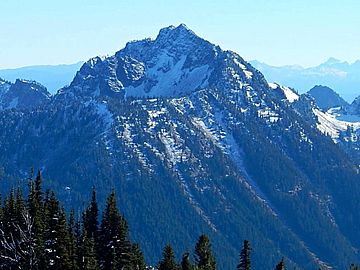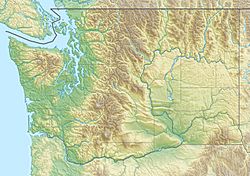Tamanos Mountain facts for kids
Quick facts for kids Tamanos Mountain |
|
|---|---|

Tamanos Mountain seen from Sourdough Ridge
|
|
| Highest point | |
| Elevation | 6,790 ft (2,070 m) |
| Prominence | 750 ft (230 m) |
| Geography | |
| Location | Mount Rainier National Park Pierce County, Washington, U.S. |
| Parent range | Cascades |
| Topo map | USGS Chinook Pass |
| Climbing | |
| Easiest route | Scrambling class 3 |
Tamanos Mountain is a cool peak that stands 6,790 feet (about 2,070 meters) tall. You can find it in Mount Rainier National Park in Washington state. This mountain is part of the amazing Cascade Range, a long chain of mountains.
Tamanos Mountain sits west of Governors Ridge and northeast of the Cowlitz Chimneys. You can see all these cool spots from the Sunrise Historic District, which is a popular area in the park. The name tamanos comes from an old language called Chinook Jargon. It means guardian spirit, which is a pretty neat name for a mountain!
If you want to climb Tamanos Mountain, the usual way to start is from the Owyhigh Lakes Trail. From the lakes, you can scramble (which means climbing over rocks and rough ground using your hands and feet) up the south side to reach the very top.
Contents
Weather at Tamanos Mountain
Tamanos Mountain is in a special weather area called the marine west coast climate zone. This means it gets a lot of weather from the Pacific Ocean.
How Weather Works Here
Most of the weather systems, like big clouds and storms, start over the Pacific Ocean. They then travel northeast towards the Cascade Mountains. When these weather systems hit the tall mountains, they are forced to rise up. This is called orographic lift. As the air rises, it cools down and drops its moisture. This causes a lot of rain or snowfall to fall on the Cascades.
Winter and Summer Weather
Because of this, the west side of the Cascades gets a lot of rain and snow, especially in winter. During winter, it's usually cloudy. But in summer, high-pressure systems over the Pacific Ocean often bring clear skies.
Snow and Water
The snow here tends to be wet and heavy because of the ocean's influence. This can sometimes lead to a high risk of avalanches, which are large slides of snow down a mountain. All the rain and snow that falls on Tamanos Mountain eventually flows into the White River.



